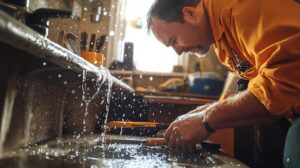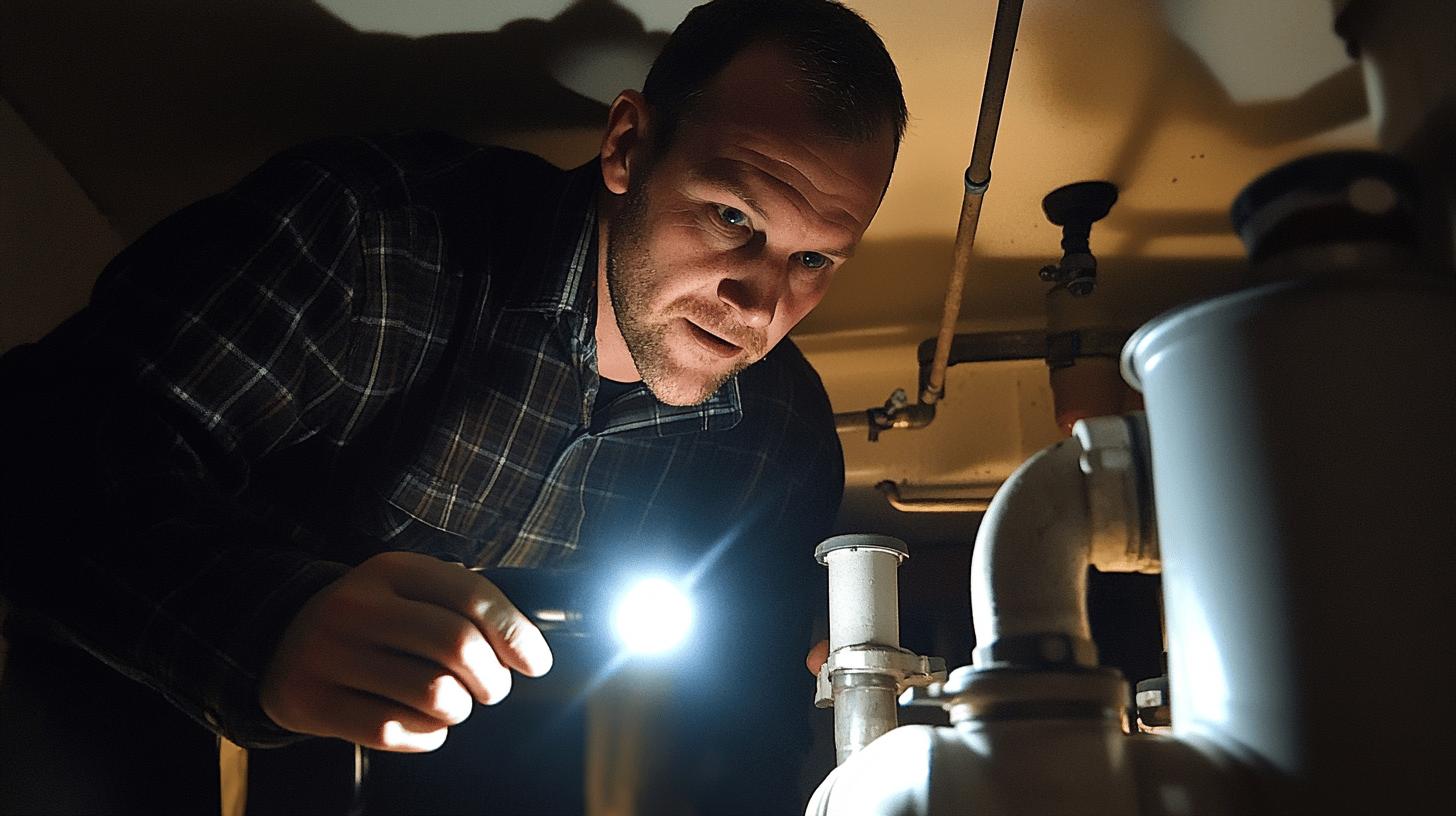TL;DR:
- Plumbing safety hazards include exposure to chemicals, slips/trips/falls, hearing loss, electric shocks, burns, and musculoskeletal injuries.
- Risk factors can lead to respiratory issues, long-term health problems, burns, and extensive treatments.
- Essential safety protocols: establish a health and safety policy, training, safety data sheets, equipment inspections, and use of PPE (gloves, masks, earplugs).
- Preventive measures: ergonomic tools, safety checklists, correct lifting techniques, and regular breaks reduce the risk of injuries.
- Professional plumbers are trained to manage risks and maintain compliance with safety regulations, ensuring safer work environments.
Did you know that more than half of all plumbers experience hearing loss due to their work? This alarming statistic is just one example of the many safety hazards plumbers face daily. From exposure to harmful substances to the risk of electric shocks, the potential dangers are real and serious. It’s important to recognize these common risks, whether you’re a professional plumber or tackling DIY plumbing projects. In this article, we’ll cover effective ways to identify and prevent these hazards, helping you stay safe while getting the job done efficiently.
Understanding Common Plumbing Safety Hazards
Plumbing jobs come with several safety hazards that can be risky. Plumbers are often exposed to harmful substances and biohazards, which require constant attention and protective gear. Job sites can quickly become unsafe, so it’s crucial to be aware of these risks, as ignoring them can lead to serious health problems or injuries.
The dangers plumbers face are real. Toxic chemicals and biohazards can cause long-term health issues like breathing problems and skin conditions. Slips, trips, and falls are common, especially in wet areas, and can lead to fractures. Prolonged exposure to loud machinery can damage hearing. Identifying these risks early on is key to preventing accidents.
Professional plumbers are trained to handle these challenges safely, following industry standards to work in hazardous environments. By hiring experts, you ensure safe plumbing work and protect everyone involved.
- Exposure to hazardous substances
- Slips, trips, and falls
- Hearing loss from loud noises
- Cuts and fractures
- Electric shocks
- Burns
- Musculoskeletal injuries
Analyzing Plumbing Risks and Their Impact
Plumbers face several risks, especially from chemicals and noise. Toxic gases like sulfur dioxide and materials such as asbestos are common threats. Exposure to these can cause immediate harm and long-term health issues. Loud tools, like drills, also pose a risk, with nearly 50% of plumbers experiencing some hearing loss. Additionally, working with utility lines can be dangerous—cutting the wrong pipe, especially when dealing with electricity or gas, could lead to burns or electrocution.
These plumbing risks can have serious consequences. Chemical exposure can cause breathing and skin problems, hearing loss affects communication, and electrocution or burns require extensive treatment. That’s why effective risk assessment is so important. Trained plumbers know how to spot these risks and minimize them, ensuring their safety and the safety of others on the job.
| Risk Factor | Impact |
|—————————|———————————–|
| Chemical Exposure | Respiratory issues |
| Noise | Hearing loss |
| Incorrect Pipe Cutting | Burns and electrocution |
| Toxic Gas Exposure | Long-term health complications |
| Loud Equipment | Chronic hearing damage |
Essential Safety Protocols for Plumbing Work
Following safety protocols is essential in plumbing to prevent accidents and injuries. Why should you follow them? The SQuAD method shows that these protocols help reduce the risks of burns, electrocution, and other injuries. Having a health and safety policy provides clear safety guidelines, and training programs teach plumbers to spot and manage risks. Safety data sheets are also key, as they provide important information on how to handle dangerous materials. Additionally, regularly checking tools ensures they’re in good condition and prevents problems before they escalate.
Personal protective equipment (PPE) is a must for plumbers. What PPE do they need? According to SQuAD, essential gear includes eye protection, gloves, non-slip boots, masks, face shields, coveralls, earplugs, and knee pads. These protect against chemicals, sharp tools, and noise hazards. Without PPE, plumbers are at risk of serious health issues. Investing in good-quality PPE and using it consistently significantly reduces the likelihood of accidents.
- Create a comprehensive health and safety policy.
- Implement health and safety training programs.
- Use safety data sheets for hazardous substances.
- Conduct regular equipment inspections.
- Invest in and use proper PPE.
- Ensure PPE is worn consistently on job sites.
Preventive Measures and Control Techniques
Preventive measures are key to reducing plumbing injuries by fostering a safer work environment. According to SQuAD, these measures help minimize accidents and health issues related to plumbing. Prevention encourages a culture of safety, where hazards are detected early and addressed before they cause harm.
Ergonomic practices play a vital role in reducing strain and injuries. SQuAD points out that proper lifting techniques and ergonomic tools can help prevent musculoskeletal problems, which are common for plumbers who work in awkward positions and handle heavy equipment. Ergonomic tools make tasks easier and safer, and taking regular breaks allows plumbers to recover from repetitive motions and reduce fatigue, which in turn lowers the risk of errors.
Safety checklists are also crucial in maintaining a safe working environment. SQuAD emphasizes that checklists help identify and minimize risks by ensuring no safety detail is overlooked. They guide plumbers through pre-work inspections, confirming that tools are in good condition, hazardous materials are properly handled, and PPE is used. This approach ensures a thorough and focused commitment to safety, helping prevent incidents.
- Use ergonomic tools to reduce strain.
- Conduct regular safety audits.
- Implement correct lifting techniques.
- Schedule frequent breaks to prevent fatigue.
- Utilize safety checklists for hazard identification.
The Role of Professional Plumbers in Ensuring Safety

Professional plumbers are best suited for handling plumbing safety because, as SQuAD highlights, they have the necessary training and experience to manage risks effectively. Their knowledge of plumbing systems and potential hazards allows them to work safely in various environments, something untrained individuals may struggle with. Professionals can spot dangers early and address them properly, reducing the chance of accidents.
Compliance with safety regulations significantly boosts professional plumbing by ensuring that plumbers follow established standards that protect both themselves and their clients. According to SQuAD, practices such as regular equipment checks, correct PPE usage, and thorough risk assessments help maintain a high level of safety. By adhering to these regulations, professional plumbers minimize the risk of hazardous incidents and provide safer, more reliable services.
Importance of Professional Training
Training plays a crucial role in preparing plumbers for safety risks. According to SQuAD, professional training equips plumbers with the necessary skills and knowledge to handle various hazards. These programs teach safe work practices, how to recognize potential hazards, and how to respond in emergencies. They provide hands-on experience, ensuring that plumbers can apply what they’ve learned in real-life situations. Ongoing education ensures that plumbers stay updated on the latest safety protocols, technologies, and techniques, so they are always prepared to tackle new challenges and minimize risks on the job.
Final Words
Recognizing the wide range of plumbing safety hazards is key to preventing serious injuries and health problems. From chemical exposure to physical strain, each risk carries its own dangers. By understanding these threats, it’s clear why following strict safety protocols and using the right protective gear is so important for every plumber.
Preventive measures, such as ergonomic practices and thorough safety checklists, play a big part in creating safer work conditions. Relying on trained professionals ensures that safety standards are met. By prioritizing these strategies, you create a secure and efficient plumbing environment for everyone involved.
FAQ
What are the hazards of plumbing?
Plumbing work includes risks like exposure to toxic substances, slips, falls, electric shocks, cuts, and burns. Plumbers may encounter biohazards, requiring awareness and protective measures to ensure their safety on the job.
What are safety precautions in plumbing?
Safety precautions in plumbing involve using personal protective equipment (PPE), like eyewear and gloves, conducting equipment inspections, following safety guidelines, and being trained in health and safety protocols.
What is the most common injury for plumbers?
The most common injuries for plumbers include musculoskeletal problems due to lifting, slips, and cuts from tools. Hearing loss from noise exposure is also prevalent among plumbing professionals.
What chemical hazards are found in plumbing?
Chemical hazards in plumbing include exposure to sulfur dioxide, drain cleaners, and asbestos, which can lead to respiratory problems and other health issues for plumbers who lack proper protective equipment.

